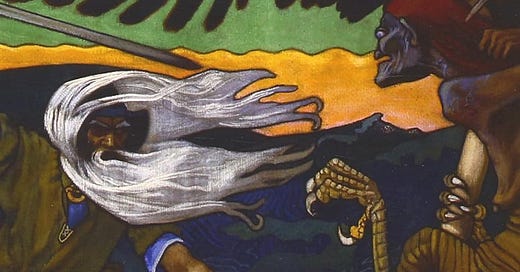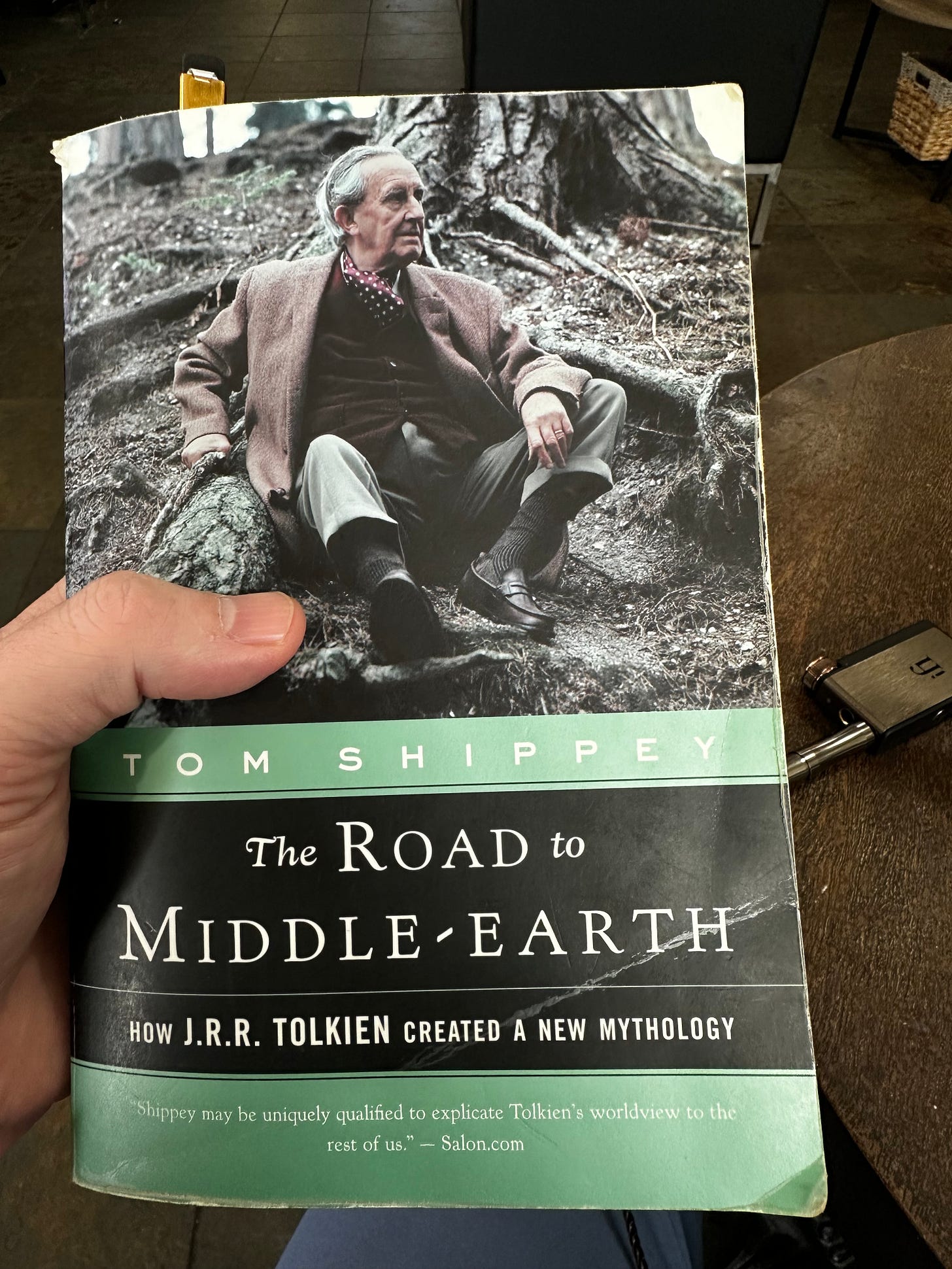Today I will list and describe some of the sources that I will be making use of during our LOTR Reading Challenge, including some of Tolkien’s other works, scholarly or critical books, reference works, and medieval and modern texts that served as Tolkien’s own sources. Also, I will link to some of my earlier writing that may be relevant.
Relevant Archival Pieces from PCF
This piece describes some of my essential ideas about Tolkien’s aesthetics and how they may relate to the music of English composer Ralph Vaughan Williams.
From the Beowulf Reading Challenge: The Dragon, the Treasure, and Radical Empathy
Tolkien wrote perhaps the single most important essay on Beowulf, which I discuss in this piece from the Beowulf Challenge. Also, because the poem was so important to him, I would suggest that the other pieces from the earlier Challenge are relevant as well, and they are all freely available in the archive.
This is my translation of one of the Old English elegies, a genre which I describe below.
Critical and Scholarly Books
Tom Shippey: The Road to Middle-Earth
For my money, this is the finest book on Tolkien. Shippey is a medievalist who has spent decades studying and teaching the same curriculum to which Tolkien dedicated his academic life. He traces the linguistic and literary sources for Middle-Earth in gratifying detail, and he also provides a useful critical vocabulary to describe Tolkien’s techniques and interests.
Tom Shippey: J.R.R. Tolkien: Author of the Century
This is very much a book of its moment, as Shippey here is largely responding to the critical backlash against Tolkien after a number of fin-de-siècle polls around the year 2000 named LOTR the best book of the century. That backlash has mostly run its course, and despite a few remaining cranky nay-sayers, Tolkien has pretty much entered the canon two decades later. However, Shippey does provide some interesting readings that situate Tolkien in his own time. He also reiterates a number of lines of argument that he had made in The Road to Middle-Earth.
John Garth: Tolkien and the Great War
A fascinating, detailed account of Tolkien’s early years and the formative friendships that helped to shape his interests in philology and medieval literature. One of the book’s claims, quite convincing to my mind, is that Tolkien’s fictional worlds are at least partly the result of the deaths of two of his closest friends in the First World War, and his dedication to carrying the torch of their mutual passions.
Other critical works will include assorted books and articles, which I will cite when we come to them.
Reference works and Tolkien’s other writing
The Oxford English Dictionary
Tolkien worked for the OED for a while, and though he had his problems with it, the dictionary remains the single most important reference work on the English language. Sometimes in the course of reading, you will find Tolkien using an archaic, unfamiliar word. In these moments, the OED is your friend.
Karen Wynn Fonstad: The Atlas of Middle Earth
If you love a map and you love Tolkien, then you need this. It confirms Tom Shippey’s point that LOTR has a “cartographic plot.”
The Annotated Hobbit
This is a lovely publication, full of illustrations from international editions and useful commentary by Douglas A. Anderson. It also includes, crucially, the original version of Chapter 5, “Riddles in the Dark,” Bilbo’s encounter with Gollum, which Tolkien revised radically to make it fit with LOTR.
The Letters of J.R.R. Tolkien, edited by Humphrey Carpenter
Tolkien was an entertaining correspondent—sometimes revelatory, sometimes evasive, and often curmudgeonly.
The History of Middle Earth in twelve volumes, edited by Christopher Tolkien
This is a massive collection of posthumous publications, collected and edited by Tolkien’s son. It includes The Silmarillion, Unfinished Tales, early drafts of LOTR, and much more.
Other reference works will include various lexicons and dictionaries on Old English, Middle English, Old Icelandic, English place names, and English surnames. Other works by Tolkien will include his shorter fiction and essays, which I will cite when we come to them.
Medieval and “Medievalish” Literature
Beowulf
Need I say more?
The Old English Elegies
These are Old English poems that influence much of the tone of LOTR, especially some of the poetry and the matter of Rohan. Thematically, they all deal with the transitory nature of life and the world.
The Battle of Maldon
Tolkien published an essay about this poem with a somewhat contentious claim (which I disagree with, by the way—more on this later). It includes perhaps the best single example of the “heroic code” from Old English poetry.
Sir Gawain and the Green Knight
Tolkien co-edited the standard edition of this Middle English poem, and its lexicon and weird landscapes played a role in shaping his fiction.
Icelandic literature: the sagas, the Poetic Edda, the Prose Edda
As we will see, Tolkien borrowed a great deal from medieval Icelandic literature, including most of the names of his Dwarves. (Don’t worry: there will be no Prince references in relation to Iceland during this challenge. Well, except this one. Sorry, new subscribers—inside joke; check the archive.)
The Kalevala
This is not really medieval, but rather “medievalish.” It is a collection of poetry compiled by in the 19th century by Elias Lönnrot from Finnish oral folk tradition and mythology (and, reputedly, partly from his own invention), and it became the national epic of Finland. Tolkien was fascinated by Finnish as a language and by The Kalevala as a text, and its influence can be felt in all sorts of ways.
The Stack of the Week
We stick with the Tolkienian theme for the Stack of the Week, which is The Fellowship of Oddities by
(previously titled “Fellowship of the Inklings,” which is a nod to the Oxford literary club that included Tolkien and C. S. Lewis). Tiffany is a deeply thoughtful reader and writer, who has, among other things, led group slow reads through Ishiguro’s Never Let Me Go and Salinger’s Franny and Zoey. She posts monthly roundups of her reading, which are always full of good stuff. She will also be contributing a guest post to our LOTR Challenge, so we can look forward to her insights there in a few weeks.Read her excellent piece on the use writers make of trauma:
In this piece, she makes an excellent case for the value of slow reading:
Join Tiffany’s Fellowship! Become an Inkling and/or an Oddity.
That’s all for today. The grad students were on spring break this week, but the grad-student featured post will return next week. I’ll look forward to Wednesday, when we embark on our Tolkienian journey!
Thanks for reading, from my fancy internet wizard to yours.









What a wonderful list of resources, John! I've read a couple of them, but am interested in checking out more. Tolkien and his work has been a major influence in my life, and I'm so excited for this challenge.
Thank you so much for the feature! I can't tell you what an honour it is.
Thanks for the advice John. As a languages person (17 and counting) The Road to Middle-Earth which has just arrived speaks to me. I still await your recommendation for the LOTR text. It is on its way from America to London. But his is most helpful in the meantime.